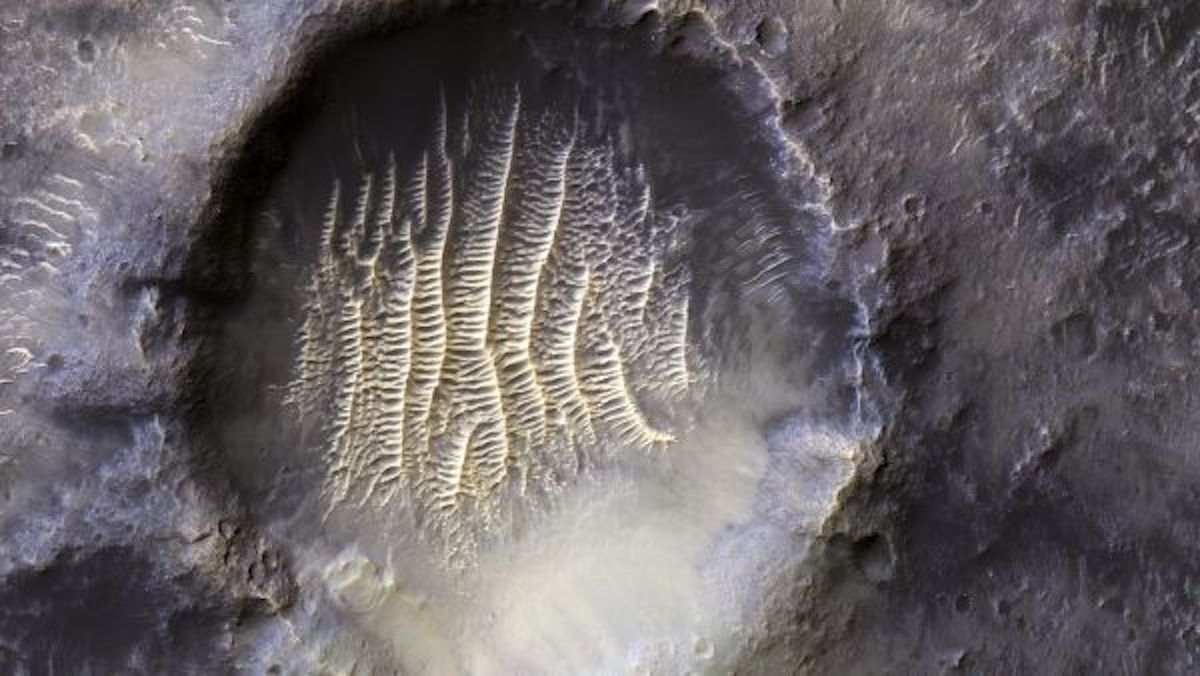Martian crater looks just like a human fingerprint in this incredible new image
The crater officially marks a halfway point on the Red Planet.

NASA has released a stunning image of a unique crater on Mars with strange, luminous ridges that give it the appearance of a human fingerprint.
The crater in the photo is known as Airy-0, a 0.3-mile-wide (0.5 kilometer) depression that sits within the much larger Airy crater, which is around 27 miles (43.5 km) wide. The newly released picture was taken on Sept. 8, 2021, using the High-Resolution Imaging Science Experiment on NASA's Mars Reconnaissance Orbiter and was shared by NASA in an Instagram post on April 11.
In 1884, astronomers originally chose the larger Airy crater to mark Mars' prime meridian, the lineof zero degrees longitude where East meets West, according to NASA. On Earth, the prime meridian is marked by the Greenwich Royal Observatory in the U.K., which denotes the boundary between the Eastern and Western hemispheres. The Airy craters are named after British astronomer Sir George Biddell Airy, who built the telescope at the Greenwich Royal Observatory that first spotted the massive crater.
Related: Curiosity rover snaps close-up of tiny 'mineral flower' on Mars
Astronomers chose Airy to mark the Martian prime meridian because it was large enough to be seen by telescopes at the time. "But as higher resolution photos became available, a smaller feature was needed," NASA representatives wrote on Instagram. Scientists chose Airy-0 to replace Airy as the prime meridian marker because it was the right size but would not require drastic changes to existing maps, according to the post.
The Airy crater is located in a region known as Sinus Meridiani, which translates to "Middle Bay," according to NASA.
The luminous ridges in the crater are known as transverse aeolian ridges (TARs), Abigail Fraeman, a planetary scientist and deputy project scientist for NASA's Curiosity rover, told Live Science. "TARs are a feature we commonly see in craters and other depressions on Mars," she added.
Get the Space.com Newsletter
Breaking space news, the latest updates on rocket launches, skywatching events and more!
The ridges are formed by sand dunes that get covered by a thin layer of dust, Fraeman said. The dust that covers the TARs in Airy-0 is most likely hematite, a mineral made from iron oxide, which is abundant in the surrounding region and gives the ground a gray color in the photo. The hematite dust is likely reflective, which makes the TARs stand out from the rest of the crater.
This is not the first time strange lines have been observed in Martian craters.
On March 30, the European Space Agency (ESA) released images of a pair of craters taken by ESA's Mars Express orbiter. One of these craters showed evidence of "brain terrain," ripples that appeared remarkably similar to the ridges on a human brain. However, these lines were caused by ice deposits rather than TARs, Live Science's sister site Space.com reported.
In June 2021, the ExoMars Trace Gas Orbiter — a joint mission by ESA and Russia's space agency, Roscosmos — captured images of a perplexing crater with concentric, "tree-like" rings. Again, these features were more likely due to ice from the comet that birthed it, and not TARs, Live Science previously reported.
Join our Space Forums to keep talking space on the latest missions, night sky and more! And if you have a news tip, correction or comment, let us know at: community@space.com.

Harry is a U.K.-based staff writer at Live Science. He studied Marine Biology at the University of Exeter (Penryn campus) and after graduating started his own blog site "Marine Madness," which he continues to run with other ocean enthusiasts. He is also interested in evolution, climate change, robots, space exploration, environmental conservation and anything that's been fossilized. When not at work he can be found watching sci-fi films, playing old Pokemon games or running (probably slower than he'd like).










